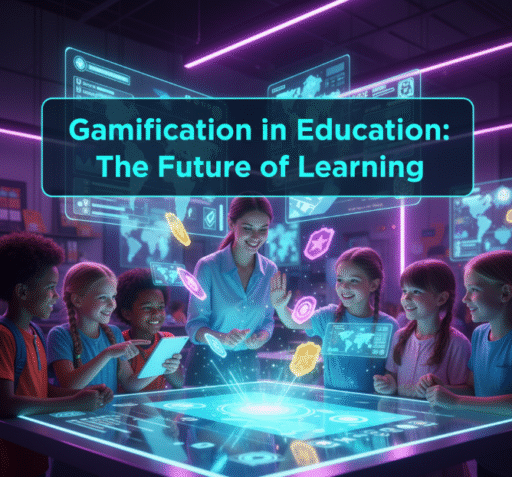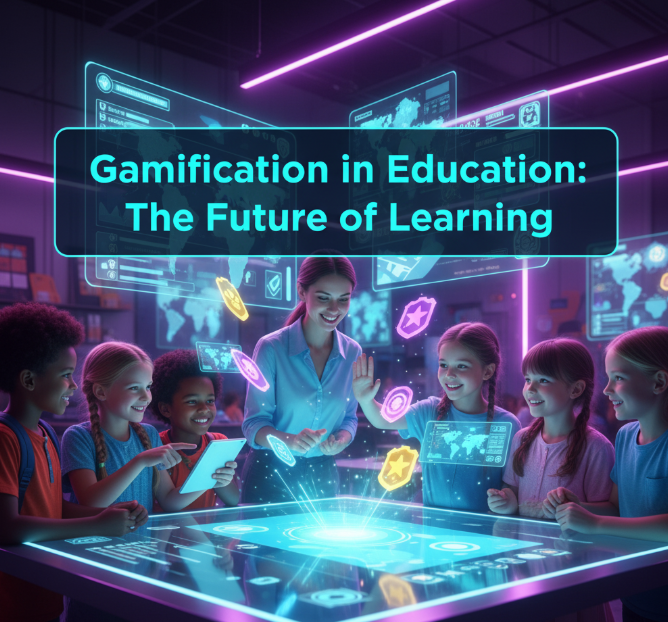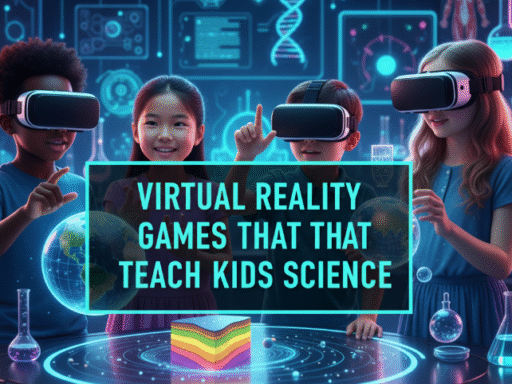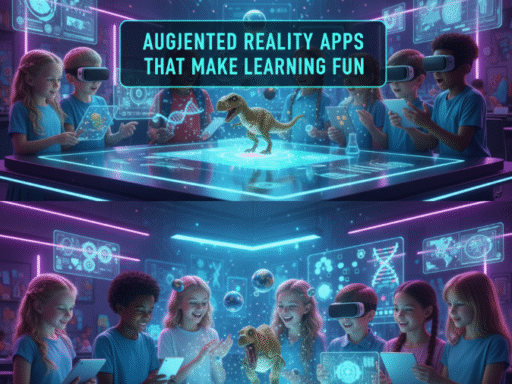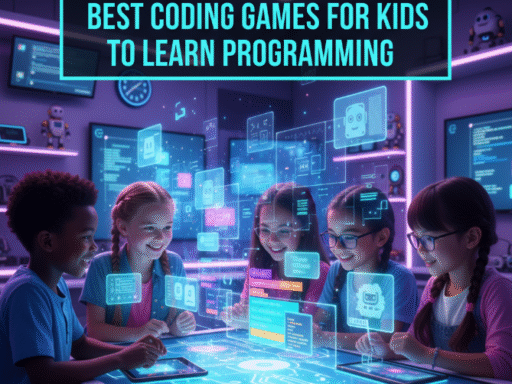Introduction
Imagine if every math problem you solved earned you points, if writing essays unlocked new levels, and if classroom participation came with exciting rewards. That’s not just a dream—it’s the power of gamification in education.
Gamification means taking elements that make games fun—like points, levels, badges, and challenges—and using them in non-game settings, especially in schools and online learning. Over the last decade, this approach has changed the way students learn, making lessons more interactive, motivating, and enjoyable.
As technology continues to shape classrooms, gamification is emerging as the future of learning. It goes beyond textbooks and lectures, creating experiences where students actively engage, compete, and collaborate. This article will explore how gamification works in education, its benefits, challenges, and what the future holds.
What is Gamification in Education?
Gamification is not about turning lessons into video games. Instead, it’s about applying game-like features to everyday learning activities.
Common Gamification Elements in Classrooms:
-
Points and Scores: Rewarding students for completing tasks.
-
Badges and Achievements: Recognizing progress and milestones.
-
Leaderboards: Encouraging healthy competition among students.
-
Levels and Progression: Unlocking new content as students advance.
-
Quests and Challenges: Turning assignments into exciting missions.
-
Storytelling: Framing lessons around engaging narratives.
When these elements are applied to learning, students are more likely to stay motivated and retain knowledge.
Why Gamification is Transforming Education
Traditional education often struggles to keep students interested. Long lectures, heavy books, and repetitive exercises can feel boring. Gamification solves this problem by making learning feel like play.
Benefits for Students:
-
Increased Motivation – Students look forward to earning rewards.
-
Better Engagement – Learning becomes active instead of passive.
-
Improved Retention – Game-like challenges help students remember concepts.
-
Collaboration Skills – Multiplayer tasks promote teamwork.
-
Confidence Building – Small achievements create a sense of accomplishment.
Benefits for Teachers:
-
Tools to track student progress easily.
-
Ability to personalize learning paths.
-
Increased participation in class discussions.
-
Creative ways to teach difficult subjects.
How Gamification Works in Different Subjects
| Subject | Example of Gamification | Impact on Learning |
|---|---|---|
| Math | Solving equations to earn points or unlock higher levels. | Builds problem-solving confidence and reduces fear of math. |
| Science | Virtual lab experiments as interactive quests. | Makes abstract concepts hands-on and fun. |
| History | Role-playing as historical figures in a timeline game. | Helps students connect emotionally with past events. |
| Language Arts | Storytelling challenges where students write to “unlock” new chapters. | Boosts creativity and writing skills. |
| Physical Education | Fitness apps with step challenges and leaderboards. | Encourages active lifestyles through fun competition. |
This table shows how gamification can be applied across all subjects, proving it’s not limited to just technology-based courses.
Real-Life Examples of Gamified Learning
Several apps, platforms, and schools have successfully applied gamification in education:
-
Duolingo: A language learning app that uses streaks, levels, and rewards to keep users engaged.
-
Kahoot!: A classroom quiz game that makes tests exciting through live competition.
-
Minecraft Education Edition: Teaches coding, history, and science through interactive worlds.
-
Classcraft: Turns classroom management into a role-playing adventure.
These platforms show how gamification can blend fun with serious learning.
Why Students Love Gamified Learning
When learning feels like a game, students experience emotions like excitement, curiosity, and achievement. This emotional connection is what makes gamification so powerful.
Key Reasons Students Enjoy It:
-
Instant Feedback: They know immediately if they are right or wrong.
-
Freedom to Try Again: Failure is seen as part of the process, just like in games.
-
Sense of Progress: Levels and badges give a visible sign of growth.
-
Friendly Competition: Leaderboards push students to try harder.
A traditional classroom might hand out grades once a month, but gamification gives real-time feedback—keeping students hooked.
Challenges of Gamification in Education
Like any system, gamification isn’t perfect.
Common Challenges:
-
Overemphasis on Rewards: Students may focus only on points, not knowledge.
-
Technology Gaps: Not all schools have access to modern tools.
-
Teacher Training: Educators need time to learn how to apply gamification effectively.
-
Balance Issues: Too much competition may discourage weaker students.
-
Sustainability: Keeping gamified lessons fresh and interesting takes effort.
These challenges show that gamification needs careful planning to succeed.
The Psychology Behind Gamified Learning
Gamification works because it taps into basic human psychology.
Psychological Principles in Action:
-
Dopamine Release: Small rewards trigger feelings of happiness and motivation.
-
Progress Tracking: Visible growth encourages continued effort.
-
Competition and Collaboration: Both drive engagement depending on the student’s personality.
-
Curiosity and Exploration: Challenges and quests make students want to discover more.
This combination makes learning addictive in a positive way.
The Future of Gamification in Education
Emerging Trends:
-
Virtual Reality (VR) Classrooms – Students can explore ancient civilizations or dissect a frog in 3D worlds.
-
Augmented Reality (AR) Lessons – Interactive overlays that bring textbooks to life.
-
AI-Powered Learning Paths – Personalized quests designed for each student’s strengths and weaknesses.
-
Global Classrooms Through Games – Students from different countries collaborating in multiplayer learning environments.
-
Gamified Assessments – Exams that feel like missions instead of stressful tests.
As technology grows, gamification will become even more advanced, blending real-world education with game-like interactivity.
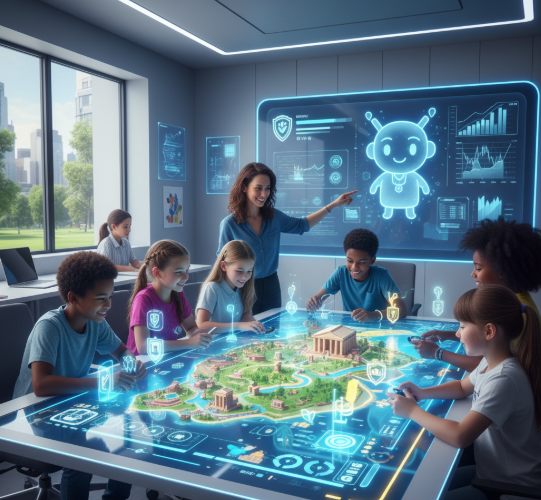
Practical Tips for Teachers to Apply Gamification
Here’s how educators can start integrating gamification in small steps:
-
Start with Points and Badges – Reward daily achievements.
-
Introduce Leaderboards Carefully – Keep them friendly, not discouraging.
-
Use Storytelling – Wrap lessons around a fun narrative.
-
Mix Competition with Collaboration – Balance individual rewards with team-based challenges.
-
Leverage Free Tools – Apps like Kahoot! and Quizizz are easy starting points.
When done right, even small doses of gamification can make a big difference.
Infographic: Gamification at a Glance
Gamification Formula for Learning Success:
📘 Learning Content + 🎮 Game Elements + 🏆 Rewards + 👩🏫 Teacher Guidance = 🚀 Engaged Students
(Visual idea: A pyramid with these elements stacked for easy understanding.)
Frequently Asked Questions (FAQs)
Q1. Is gamification the same as playing video games in class?
No. Gamification adds game-like features to lessons but doesn’t turn the class into a full video game.
Q2. Does gamification work for all ages?
Yes, from elementary students to college learners, gamification can be adapted for every age group.
Q3. Will gamification replace teachers?
No. Teachers are essential guides. Gamification only adds tools to make their lessons more engaging.
Q4. Can gamification improve exam performance?
Yes. By making practice enjoyable, students are more likely to study consistently, which leads to better results.
Conclusion
Gamification is more than just a trend—it’s the future of education. By blending fun and learning, it creates classrooms where students feel motivated, challenged, and excited to grow.
From language apps like Duolingo to classroom tools like Kahoot!, gamification has already proven its value. The future holds even greater possibilities with VR, AR, and AI-driven learning.
While challenges exist, the benefits far outweigh the drawbacks. With thoughtful application, gamification can transform dull lessons into adventures and exams into missions.
The future of learning isn’t about choosing between education and play—it’s about combining them. And gamification is the bridge that makes it possible.
